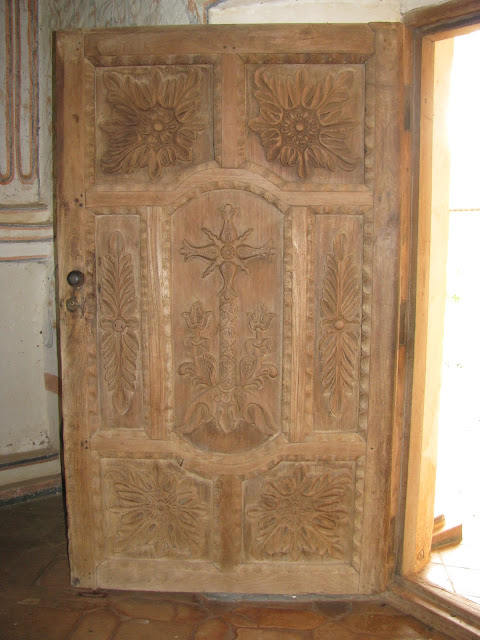An hour’s flight southeast lands us in Bolivia’s largest city, Santa Cruz, in the foothills of the Oriente. Renowned as one of the main centers of the cocaine trade, today it is more in the news as the center of the controversial energy sector and its overwhelming desire for the region’s autonomy from the rest of Bolivia.
An original window with round glass inserts.
Further along the road lies Concepción, a dusty village with a friendly, quiet atmosphere in the midst of an agricultural and cattle-ranching area. We are treated to a tour of an orchid farm by the gardener himself located on the property of the hotel we are staying at. He propagates hundreds of rare and expensive orchids.
We visit the restoration workshops of the mission where many of the fine replicas and restored artworks are crafted.
These guys are everywhere in Concepción. We won’t complain about the mosquitos in Whistler ever again.
The elaborately restored 1709 Catedral de Concepción has an overhanging roof supported by 121 huge tree-trunk columns and a similar bell tower. It is decorated with baroque designs depicting flowers, angels and the Holy Virgin. The decor gives some idea of the former opulence of the village.
The road from Concepción onwards is mostly unpaved. Only 2,496km out of 49,311km of Bolivia’s highways are paved making for some of the bumpiest and most poorly maintained roads in the world.
The baroque style church of San Ignacio de Velasco, (above), built between 1749 y 1752, and restored between1987 and 1993, is part of the first Jesuit mission in Chiquitos founded in 1691.
San Miguel was founded in 1721 and is a small town, with less than 5,000 inhabitants. Like its sister communities of Santa Ana and San Rafael, San Miguel is a quiet spot where time seems to have stood still for the past three centuries. Its church is considered the most historically accurate of all the restored Jesuit churches.
San Rafael, the second oldest mission settlement, was established in 1696 and shares many of the same characteristics that nearby Santa Ana de Velasco and San Miguel de Velasco possess: a timeless charm, tranquil lifestyle, and fidelity to its Jesuit-inspired traditions.
Santa Ana de Velasco was established in 1755. The church, with its earthen floor and interior palm-frond roof, is more rustic than the others and recalls the first churches constructed by the Jesuit missionaries upon their arrival.
There are few attractions here except for the shady retreat of Plaza 24 de Septiembre and its cathedral (above) and our main purpose for being here is to embark on a tour of the historic Jesuit missions.
The parrot telephone booth could be considered another attraction.
From the late 17th century, Jesuits established settlements called reducciones in Bolivia’s eastern lowlands, building churches, establishing farms and instructing the indigenous in religion, agriculture, music and crafts in return for conversion to Christianity and manual labour. Victims of their own success, they were expelled from South America in 1773. We set out to visit some of these missions.
Along the way to San Javier we pass through Mennonite communities and see the landscape change from farmland to tropical shrubbery.
San Javier was founded in 1691 and at its height included about 3,000 people. This remarkable church was constructed entirely of local wood. The ornate wood carvings painted with local dyes are quite spectacular and the gold-coloured interior is just as impressive.
An original window with round glass inserts.
Further along the road lies Concepción, a dusty village with a friendly, quiet atmosphere in the midst of an agricultural and cattle-ranching area. We are treated to a tour of an orchid farm by the gardener himself located on the property of the hotel we are staying at. He propagates hundreds of rare and expensive orchids.
We visit the restoration workshops of the mission where many of the fine replicas and restored artworks are crafted.
Saint Ignatius was the founder of the Jesuit order.
These guys are everywhere in Concepción. We won’t complain about the mosquitos in Whistler ever again.
The elaborately restored 1709 Catedral de Concepción has an overhanging roof supported by 121 huge tree-trunk columns and a similar bell tower. It is decorated with baroque designs depicting flowers, angels and the Holy Virgin. The decor gives some idea of the former opulence of the village.
The road from Concepción onwards is mostly unpaved. Only 2,496km out of 49,311km of Bolivia’s highways are paved making for some of the bumpiest and most poorly maintained roads in the world.
The baroque style church of San Ignacio de Velasco, (above), built between 1749 y 1752, and restored between1987 and 1993, is part of the first Jesuit mission in Chiquitos founded in 1691.
San Miguel was founded in 1721 and is a small town, with less than 5,000 inhabitants. Like its sister communities of Santa Ana and San Rafael, San Miguel is a quiet spot where time seems to have stood still for the past three centuries. Its church is considered the most historically accurate of all the restored Jesuit churches.
San Rafael, the second oldest mission settlement, was established in 1696 and shares many of the same characteristics that nearby Santa Ana de Velasco and San Miguel de Velasco possess: a timeless charm, tranquil lifestyle, and fidelity to its Jesuit-inspired traditions.
Santa Ana de Velasco was established in 1755. The church, with its earthen floor and interior palm-frond roof, is more rustic than the others and recalls the first churches constructed by the Jesuit missionaries upon their arrival.













































No comments:
Post a Comment